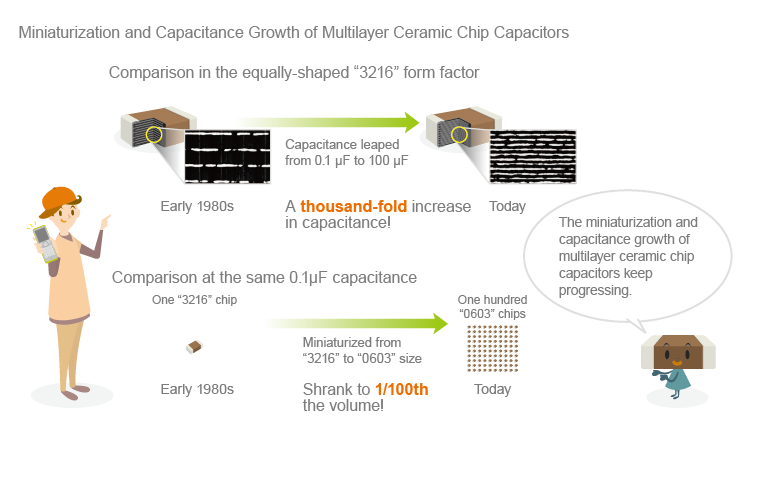Understanding the Types and Roles of Capacitors through Five Articles | The World of Power Capacitors
Part 4: The Capacitor is the Hidden Star of Electronic Circuits—Role #3: Resonant and Oscillating Circuits

The two basic properties of a capacitor are that it can store electric charges and that it passes higher-frequency AC currents more easily. However, in high-frequency ranges, the capacitor begins to reveal a different side. This is because the subtle inductive component within the capacitor becomes more dominant, and the capacitor alone begins to behave like a resonant circuit. Resonant circuits, which combine a capacitor and an inductor (coil), are indispensable for tuning in communication and broadcasting equipment. Before explaining how resonant circuits work, let’s first review the history of radio (electromagnetic) waves and wireless communication technologies.
- Electric sparks from the Leyden jar helped prove the existence of electromagnetic waves

- A dipole antenna is structured like a capacitor with its electrodes spread open

- A tuned circuit composed of a capacitor and an inductor

- The impedance of capacitors does not drop at high frequencies because they self-resonate

- ESL of capacitors is closely related to noise removal effectiveness

Electric sparks from the Leyden jar helped prove the existence of electromagnetic waves
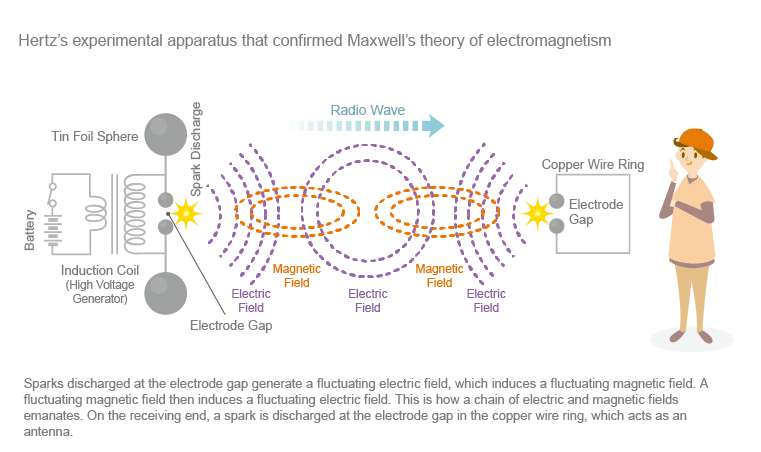
A dipole antenna is structured like a capacitor with its electrodes spread open
In Heinrich Hertz’s experimental apparatus, the gap between the electrodes was the transmitting antenna. This works in the same way as the electrodes of a capacitor. In other words, the capacitor is also the origin of the radio antenna. A dipole antenna, for example, can be construed as a capacitor with its two electrodes spread open horizontally. A generic TV receiver antenna (the “Yagi-Uda” design) shares the same basic design. Incidentally, the word “antenna” derives from “antennae”—the appendage found in insects.
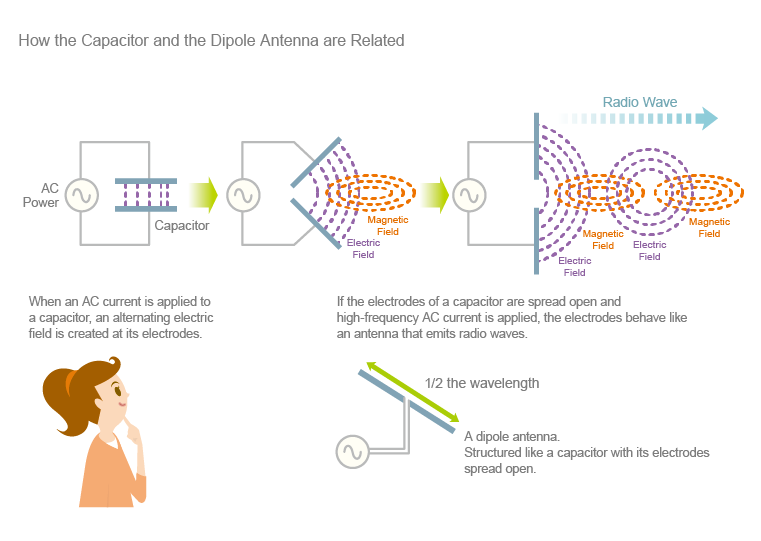
A tuned circuit composed of a capacitor and an inductor
Marconi’s early radio transmitter and Hertz’s experimental apparatus were based on the same working principle. They sent signals using spark discharges to generate electromagnetic waves intermittently, like a smoke signal. Similarly, the pop you hear when you ignite an electronic cigarette lighter near a radio is caused by the electromagnetic waves generated. These types of waves are referred to as white noise, which comprises a mixture of different frequency components. As interest in wireless communication climbed, people began to look for ways to designate specific frequencies in order to solve interference problems and extend range. It was during the course of such research that tuned circuits and oscillation circuits utilizing capacitors and inductors (coils) were devised.
Let’s begin with the tuned circuit. There are two types of tuned circuits: one with a capacitor and an inductor are connected in series, and the other where the two components are connected in parallel. As mentioned in the previous article, capacitors pass AC current at higher frequencies more easily, while inductors exhibit the opposite property of impeding them. However, when the two are combined as shown in the figure below, the frequency response curves of the two components intersect—at which point they resonate, and the impedance (resistance in AC) changes sharply. (When connected in series, the impedance dips; when in parallel, it spikes.) This phenomenon is utilized in tuning circuits to select a specific frequency, called the resonant frequency.
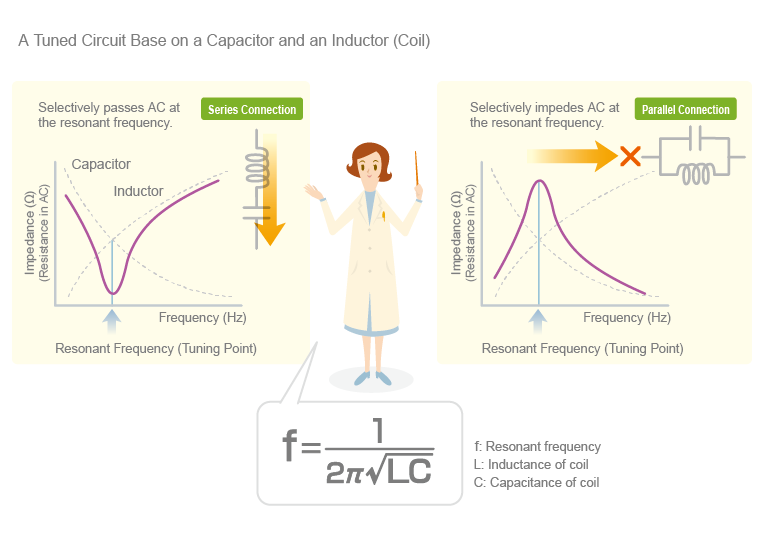
The impedance of capacitors does not drop at high frequencies because they self-resonate
Passing higher-frequency AC current more easily is a fundamental property of capacitors. However, this is only true for a theoretically perfect capacitor—in practice, capacitors behave in peculiar ways at high frequencies. This is because capacitors in real life possess resistive and inductive components.
For example, in a multilayer ceramic chip capacitor, some loss is incurred when the dielectric is polarized; the internal electrodes also have their own resistance and inductance. In electrolytic capacitors, resistance and inductance are found in the aluminum foil, the cathode’s electrolyte and the leads. These are called ESR (Equivalent Series Resistance) and ESL (Equivalent Series Inductance), respectively. When capacitors are used in high-frequency ranges, the effects of ESR and ESL—which are not explicitly drawn on circuit diagrams—become pronounced. This is a critical perspective when considering high-frequency filters and noise countermeasures.
ESR—which is a resistive component—constitutes a loss of energy, so it should be as low as possible, especially where large, high-frequency currents flow. ESL, on the other hand, significantly affects the behavior of capacitors in high-frequency ranges. Like the resonant circuit described above—where a capacitor and an inductor are connected in series—the capacitance (C) and ESL engender a phenomenon known as series resonance. As shown in the figure below, the impedance drops, then rises again above a certain frequency. The resonant frequency that forms this boundary is also called SRF (Self-Resonant Frequency). At frequencies above the SRF, the capacitor behaves more like an inductor, where ESL defines the characteristics.
Because multilayer ceramic chip capacitors have a simple structure composed of a ceramic dielectric and metallic internal and terminal electrodes, they feature lower ESR and ESL compared to other types of capacitors. They are small, lightweight and highly reliable with outstanding high-frequency response characteristics, representing a highly desirable balance of attributes—which is why they account for more than 80% of all capacitors produced in the world today.
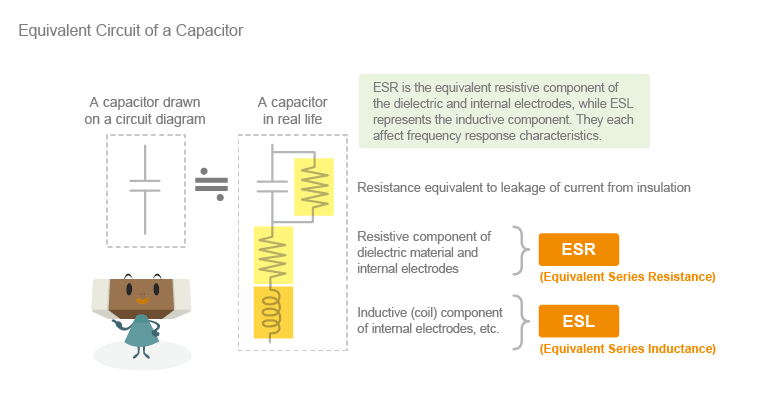
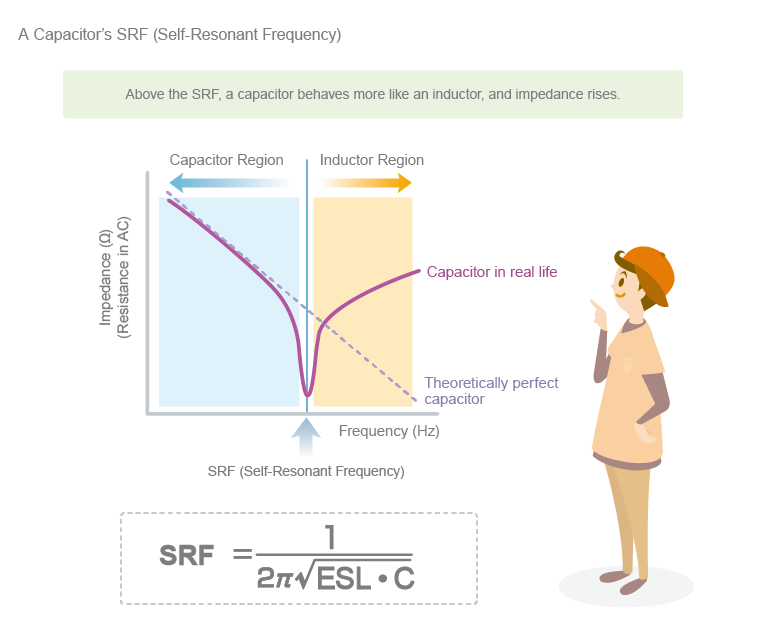
ESL of capacitors is closely related to noise removal effectiveness
If a capacitor with a large ESL is used as a bypass capacitor, the impedance will not drop sufficiently, and noise will not be removed. Because noise is a high-frequency current, it will not flow through the capacitor if the impedance is too high, making it unable to be redirected.
Generally, high-frequency bypassing is performed by multilayer ceramic chip capacitors. However, due to the speed increase of digital circuits in recent years, noise frequencies have also increased, and cases where low-ESL capacitors are used for noise suppression are growing, as shown in the figure below.
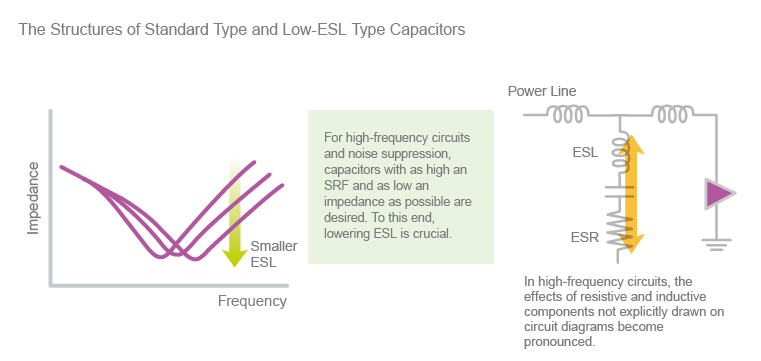
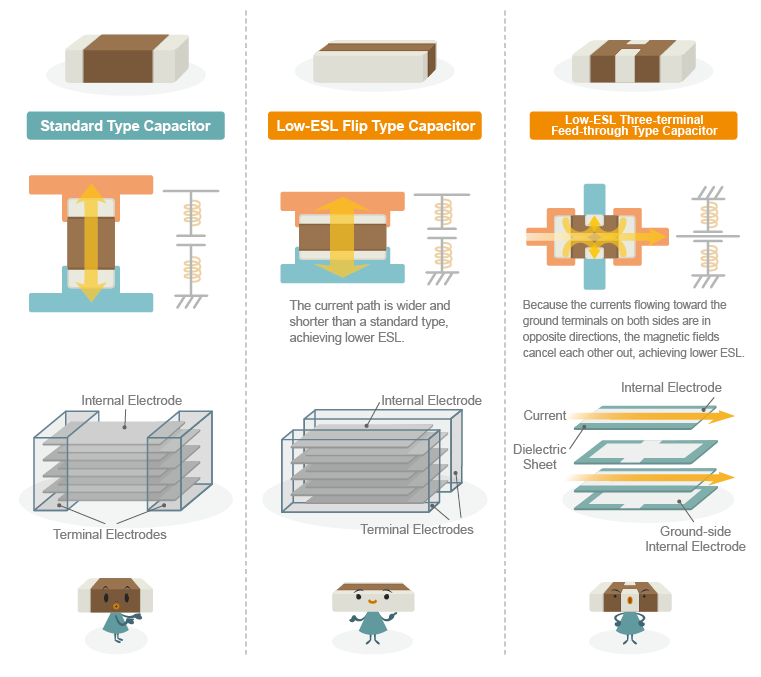
TDK is a comprehensive electronic components manufacturer leading the world in magnetic technology



